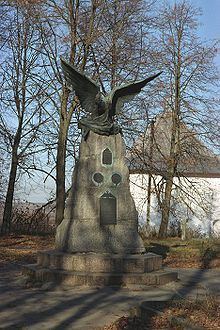Coat of arms Flag Urban settlement Vyazemskoye | Local time Wednesday 1:35 PM | |
 | ||
Weather 10°C, Wind S at 18 km/h, 65% Humidity Points of interest Local History Museum, Vyazemskiy istoriko‑kraevedcheskiy muzey - vy, Pamyatnik Nakhimovu P S, Pamyatnik generalu Efremovu, Pamyatnik Pernovskomu polku | ||
Vyazma (Russian: Вя́зьма) is a town and the administrative center of Vyazemsky District in Smolensk Oblast, Russia, located on the Vyazma River, about halfway between Smolensk, the administrative center of the oblast, and Mozhaysk. Throughout its turbulent history, it defended western approaches to Moscow. Population: 57,101 (2010 Census); 57,545 (2002 Census); 59,022 (1989 Census); 44,000 (1970).
Contents
- Map of Vyazma Smolensky Russia
- Russia russia vyazma
- Medieval history and monuments
- Battles of Vyazma
- Administrative and municipal status
- Economy
- Transportation
- Education
- Sports
- Notable people
- References
Map of Vyazma, Smolensky, Russia
Russia russia vyazma
Medieval history and monuments
Vyazma was first mentioned in a chronicle under the year of 1230, although it is believed to be much older than that. The town was named after the river, whose name was from Russian word "вязь" (vyaz'), meaning "bog" or "swamp". At the time, the town belonged to a lateral branch of the Rurikid House of Smolensk. In 1403, the local princes were expelled by Lithuanians to Moscow, where they took the name of Princes Vyazemsky. The most notable among them were Pyotr Vyazemsky, an intimate friend of the poet Alexander Pushkin and a poet himself, and Sophie Viazemski, a French writer, for a time married to Jean-Luc Godard.
In 1494, Vyazma was captured by the Grand Duchy of Moscow and turned into a fortress, of which but a single tower remains. Two important abbeys were embellished with stone churches, including a rare three-tented church dedicated to Our Lady of Smolensk (Hodegetria) and consecrated in 1638 except Polish occupation between 1611–1634. A barbican church of the same abbey dates back to 1656, and the town's cathedral was completed by 1676. Other churches are designed mostly in baroque style.
Battles of Vyazma
During the French invasion of Russia in 1812, there was a battle between the retreating French army (up to 37,000 troops) and the Russian army (25,000 men) near Vyazma on October 22, 1812. The vanguard of the Russian army under the command of Lieutenant General Mikhail Miloradovich and a Cossack unit of General Matvey Platov attacked the rearguard corps of Marshal Louis-Nicolas Davout east of Vyazma and cut off his retreat. Owing to the intervention of Eugène de Beauharnais and Józef Poniatowski, Davout managed to break through the Russian army's encirclement.
However, the French army's attempts to hold the heights near Vyazma and the town itself were unsuccessful. By the evening of October 22, Russians seized Vyazma, which had been set on fire by the French. The French lost 6,000 men during the battle; 2,500 soldiers were taken prisoners. The Russians lost around 2,000 men.
In 1941, during World War II, Vyazma was the scene of a battle of encirclement. Red Army units were trapped in the town after it was surrounded by the German Third and Fourth Panzer armies. Vyazma was occupied by German forces between 7 October 1941 and 12 March 1943. In October 1941, 11 Jews were shot in the town and two were hanged. In December 1941, 117 Jews were killed in a mass execution perpetrated by the Einsatzgruppe B.
The town was heavily damaged in the fighting, then rebuilt after the war. U.S. journalist Quentin Reynolds, of Collier's Weekly, visited Vyazma shortly after the German withdrawal in 1943 and gave an account of the destruction in his book The Curtain Rises (1944), in which he stated that the town's population was reduced from 60,000 to 716, with only three buildings remaining. The Nazis also established two concentration camps in the town, Dulag 184 and Dulag 230. About 80,000 people died there and were buried in mass graves. The victims included Jews, political officers, and POWs.
Administrative and municipal status
Within the framework of administrative divisions, Vyazma serves as the administrative center of Vyazemsky District. As an administrative division, it is incorporated within Vyazemsky District as Vyazemskoye Urban Settlement. As a municipal division, this administrative unit also has urban settlement status and is a part of Vyazemsky Municipal District.
Economy
The town's main industries are engineering, leather working, graphite products, and flax textiles.
Transportation
Vyazma is a major railway junction, with connecting trains from Moscow, St. Petersburg, Kaluga, and Bryansk. It is also located near the main M1 Highway between Moscow and Minsk.
The town is served by the Vyazma Airport.
Education
In terms of education Vyazma has branches of the Moscow State Industrial University, the Smolensk Humanitarian University, the International Academy of Tourism (WF RMAT), and the Moscow State University of Technology and Management, as well as the Vyazemsky Polytechnic College.
Sports
The town association football club, FK Vyazma, plays in the Amateur football league.
The town is known for the aviation-squadron Vyazma Russ which flies in Aero L-39 Albatros jet aircraft.
